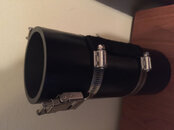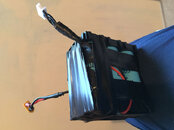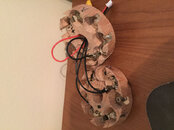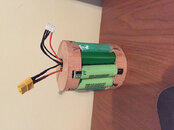ScubaBunga
Contributor
Thought I would post this - I built some battery packs and was not sure what TSA or others in line will think, so updated my plans.
I have a dive rite canister light and last time I traveled - following all TSA docs, I labeled my AGM battery as sealed, packed it in my carry-on... and got stopped and questioned at every gate check - but passed with no issues other than the search. Well my light leaked just a bit at the switch and basically the switch is now dead - so I started a path to replace the switch. In the process I decided to use some 18650 batteries to give me a longer life battery pack. The switch is now a reed magnetic switch with a mosfet (used as relay) to turn light on and off (still working on the slide holder for the external magnet - maybe a followup later, this post is about the batteries). The AGM battery is a 12v 2.9ah battery - which for usability sake is only about 1.45ah. In building my 18650 batteries ( pack of 6 batteries, 2p/3s) I end up with basically a 3.6ah (assuming my cells are about 1800ma) where most of it is usable per li-on use. I am also able to fit two of these (in parallel) in my canister. I tested this and the light (an older 20w halogen) ran for over 8 hours with plenty of battery life left when I shut it down. The AGM battery runs for about an hour and that's it.
The problem: when I stepped back and looked at packing this, I realized that a diy battery pack soldered together, electrical tape wrapped, and with wires (power cable and balancer cable) sticking out didn't seem TSA friendly. I did talk to them and after they did some research said it was ok, just get their early, put them in their own tray and give TSA time to look at them. The thought of dropping these in a container while in line did not give me confidence!
The solution, I built an assembleable (is that a word) battery pack that I can store the components in my checked bag and then just carry on a box of 18650 batteries in a much more approved and non-dangerous looking way. I made these holders out of wood with the terminals bought off amazon. I hope to eventually have these 3d printed, but for now the custom wood ones work, look good, and fit right into the canister. The bonus is before I could fit 2 6 battery packs, now I can fit 2 9 battery pack (like a 5.4ah or combined over 10ah). Once assembled I can even charge the pack as a whole as I built in the balance cable as well. I'm thinking I may be able to night dive all week and never have to recharge these packs.
I have a dive rite canister light and last time I traveled - following all TSA docs, I labeled my AGM battery as sealed, packed it in my carry-on... and got stopped and questioned at every gate check - but passed with no issues other than the search. Well my light leaked just a bit at the switch and basically the switch is now dead - so I started a path to replace the switch. In the process I decided to use some 18650 batteries to give me a longer life battery pack. The switch is now a reed magnetic switch with a mosfet (used as relay) to turn light on and off (still working on the slide holder for the external magnet - maybe a followup later, this post is about the batteries). The AGM battery is a 12v 2.9ah battery - which for usability sake is only about 1.45ah. In building my 18650 batteries ( pack of 6 batteries, 2p/3s) I end up with basically a 3.6ah (assuming my cells are about 1800ma) where most of it is usable per li-on use. I am also able to fit two of these (in parallel) in my canister. I tested this and the light (an older 20w halogen) ran for over 8 hours with plenty of battery life left when I shut it down. The AGM battery runs for about an hour and that's it.
The problem: when I stepped back and looked at packing this, I realized that a diy battery pack soldered together, electrical tape wrapped, and with wires (power cable and balancer cable) sticking out didn't seem TSA friendly. I did talk to them and after they did some research said it was ok, just get their early, put them in their own tray and give TSA time to look at them. The thought of dropping these in a container while in line did not give me confidence!
The solution, I built an assembleable (is that a word) battery pack that I can store the components in my checked bag and then just carry on a box of 18650 batteries in a much more approved and non-dangerous looking way. I made these holders out of wood with the terminals bought off amazon. I hope to eventually have these 3d printed, but for now the custom wood ones work, look good, and fit right into the canister. The bonus is before I could fit 2 6 battery packs, now I can fit 2 9 battery pack (like a 5.4ah or combined over 10ah). Once assembled I can even charge the pack as a whole as I built in the balance cable as well. I'm thinking I may be able to night dive all week and never have to recharge these packs.








